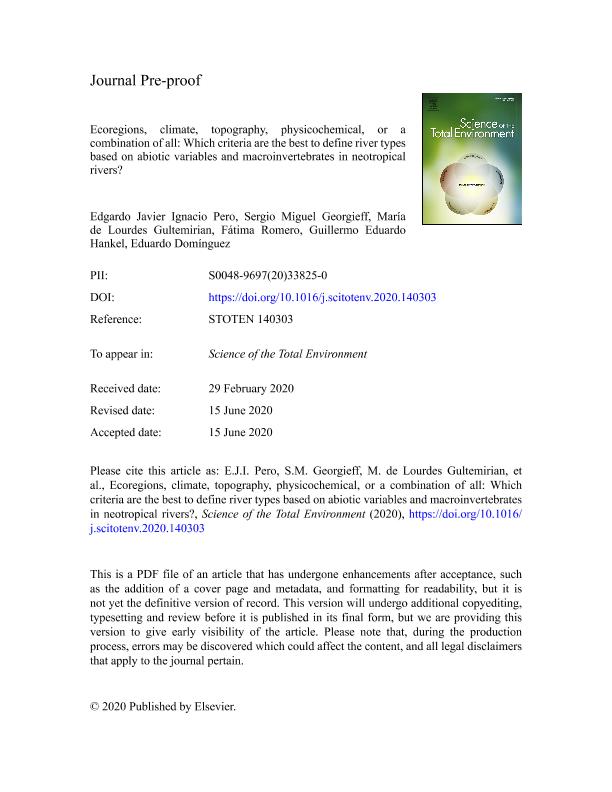Artículo
Ecoregions, climate, topography, physicochemical, or a combination of all: Which criteria are the best to define river types based on abiotic variables and macroinvertebrates in neotropical rivers?
Pero, Edgardo Javier Ignacio ; Georgieff, Sergio Miguel
; Georgieff, Sergio Miguel ; Gultemirian, Maria de Lourdes
; Gultemirian, Maria de Lourdes ; Romero, Fátima; Hankel, Guillermo Eduardo
; Romero, Fátima; Hankel, Guillermo Eduardo ; Dominguez, Eduardo
; Dominguez, Eduardo
 ; Georgieff, Sergio Miguel
; Georgieff, Sergio Miguel ; Gultemirian, Maria de Lourdes
; Gultemirian, Maria de Lourdes ; Romero, Fátima; Hankel, Guillermo Eduardo
; Romero, Fátima; Hankel, Guillermo Eduardo ; Dominguez, Eduardo
; Dominguez, Eduardo
Fecha de publicación:
18/10/2020
Editorial:
Elsevier Science
Revista:
Science of the Total Environment
ISSN:
0048-9697
Idioma:
Inglés
Tipo de recurso:
Artículo publicado
Clasificación temática:
Resumen
The baseline conditions for a particular river or stream type are essential to classify aquatic ecosystems based on physical and biological characteristics. In this study, we proposed a river typology for different ecoregions, climate and topography of northwestern Argentina using parameters, and combined key variables to establish reference conditions. A set of geographical, hydro-morphological, hydrological, geological (pedology and sedimentology) and physicochemical variables were measured from different rivers and analyzed with clustering and ordination techniques to develop a typology. We analyzed the correspondence of the physical river conditions and benthic macroinvertebrate assemblages using non-metric multidimensional scaling analysis, dissimilarity among assemblages, ANOSIM approach and envfit analysis in order to make an ecological validation of the classification. Our results allowed us to classify the neotropical rivers studied, according to typological systems adapted from the European Water Framework Directive. The combination of ecoregions and topography along with other variables associated (system B), was better corresponded with biological arrangements. Hence, ecoregions and topography combined turned out to be more precise as a criterion to define river types and their local abiotic and biotic reference conditions. Macroinvertebrate distribution corresponded with the classifications proposed and was related with abiotic features of the rivers. The physical variables as altitude, grain size, water temperature and turbidity were key parameters to develop a schematic model to define river types that could be implemented and tested in other countries of the region. Five river types have been identified, characterized, and included in three large groups: Mountains, Foothills, and Lowlands (Plains). Our results showed that topography and climate are two aspects that strongly influence South American freshwater biota. We propose the schematic model developed in our study as a baseline to define freshwater biomes based on altitude (topography), ecoregions (climate) and biological functional traits at a broad spatial scale (continental or global).
Palabras clave:
CLASSIFICATION
,
FRESHWATER ECOSYSTEMS
,
LANDSCAPE
,
SOUTH AMERICA
Archivos asociados
Licencia
Identificadores
Colecciones
Articulos(IBN)
Articulos de INSTITUTO DE BIODIVERSIDAD NEOTROPICAL
Articulos de INSTITUTO DE BIODIVERSIDAD NEOTROPICAL
Citación
Pero, Edgardo Javier Ignacio; Georgieff, Sergio Miguel; Gultemirian, Maria de Lourdes; Romero, Fátima; Hankel, Guillermo Eduardo; et al.; Ecoregions, climate, topography, physicochemical, or a combination of all: Which criteria are the best to define river types based on abiotic variables and macroinvertebrates in neotropical rivers?; Elsevier Science; Science of the Total Environment; 738; 18-10-2020; 1-20
Compartir
Altmétricas



